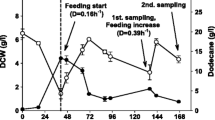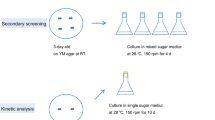Abstract
To promote the effective use of raw glycerol (a by-product of biodiesel production), 110 yeast strains that produce d-arabitol from glycerol were isolated from environmental samples. Among them, strain 17-2A was an effective d-arabitol producer in the presence of 250 g/l glycerol and was identified as Candida quercitrusa based on morphological, physicochemical, and phylogenetic analyses. C. quercitrusa type strain NBRC1022 produced the greatest quantity of d-arabitol (41.7 g/l) when the ability to produce d-arabitol from raw glycerol was compared among C. quercitrusa 17-2A and its phylogenetically related strains in flask culture. Under optimized culture conditions, strain NBRC1022 produced d-arabitol at a concentration of 58.2 g/l after a 7-day cultivation in 250 g/l glycerol, 6 g/l yeast extract, and 2 g/l CaCl2. The culture conditions were further investigated with raw glycerol using a jar fermenter; the concentration of d-arabitol reached 67.1 g/l after 7 days and 85.1 g/l after 10 days, respectively, which corresponded to 0.40 g/g of glycerol. To our knowledge, the present d-arabitol yield from glycerol is higher than reported previously using microbial production.





Similar content being viewed by others
References
Barnett JA, Payne RW, Yarrow D (2000) Yeasts: Characteristics and identification, 3rd edn. Camridge University Press, Cambridge UK
Bernard EM, Christiansen KJ, Tsang S, Kiehn TE, Armstrong D (1981) Rate of arabinitol production by pathogenic yeast species. J Clin Microbiol 14:189–194
Bisping B, Baumann U, Simmering R (1996) Effect of immobilization on polyol production by Pichia farinosa. Prog Biotechnol 11:395–401
Dills WL Jr (1989) Sugar alcohols as bulk sweeteners. Annu Rev Nutr 9:161–186
Granström TB, Izumori K, Leisola M (2004) A rare sugar xylitol. Part I: the biochemistry and biosynthesis of xylitol. Appl Microbiol Biotechnol 74:277–281
Hajny GJ (1964) D-Arabitol production by Endomycopsis chodati. Appl Environ Microbiol 12:87–92
Koganti S, Kuo TM, Kurtzman CP, Smith N, Ju LK (2011) Production of arabitol from glycerol: strain screening and study of factors affecting production yield. Appl Microbiol Biotechnol 90:257–267
Kurtzman CP, Fell JW (1998) The yeasts, a taxonomic study, 4th edn. Elsevier, Amsterdam Netherlands
Lee JK, Ha SJ, Kim SY, Oh DK (2000) Increased erythritol production in Torula sp. by Mn2+ and Cu2+. Biotechnol Lett 22:983–986
Lee JK, Oh DK, Song HY, Kim IW (2007) Ca2+ and Cu2+ supplementation increases mannitol production by Candida magnoliae. Biotechnol Lett 29:291–294
Nobre MF, da Costa MS (1985) Factors favouring the accumulation of arabinitol in the yeast Debaryomyces hansenii. Can J Microbiol 31:467–471
Nozaki H, Suzuki S, Tsuyoshi N, Yokozeki K (2003) Production of D-arabitol by Metschnikowia reukaufii AJ14787. Biosci Biotechnol Biochem 67:1923–1929
O’Donnell K (1993) Fusarium and its near relatives. In: Reynolds DR, Taylor JW (eds) The fungal holomorph: mitotic, meiotic and pleomorphic speciation in fungal systematics. CAB International, Wallingford UK, pp 225–233
Ohmori S, Ohno Y, Makino T, Kashihara T (2004) Characteristics of erythritol and formulation of a novel coating with erythritol termed thin-layer sugarless coating. Int J Pharm 278:447–457
Onishi H, Suzuki T (1970) Production of erythritol, D-arabitol, D-mannitol and a heptitol-like compound from glycerol by yeasts. J Ferment Technol 48:563–566
Saha BC, Sakakibara Y, Cotta MA (2007) Production of D-arabitol by a newly isolated Zygosaccharomyces rouxii. J Ind Microbiol Biotechnol 34:519–523
Song W, Lin Y, Hu H, Xie Z, Zhang J (2011) Isolation and identification of a novel Candida sp. H2 producing D-arabitol and optimization of D-arabitol production. Wei Sheng Wu Xue Bao 51:332–339
Suzuki S, Sugiyama M, Mihara Y, Hashiguchi K, Yokozeki K (2002) Novel enzymatic method for the production of xylitol from D-arabitol by Gluconobacter oxydans. Biosci Biotechnol Biochem 66:2614–2620
Thompson JD, Higgins DG, Gibson TJ (1994) CLUSTALW: improving the sensitivity of progressive multiple sequence alignment through sequence weighting. Position-specific gap penalties and weight matrix choice. Nucleic Acids Res 22:4673–4680
van Eck JH, Prior BA, Brandt EV (1989) Accumulation of polyhydroxy alcohols by Hansenula anomala in response to water stress. J Gen Microbiol 135:3505–3513
van Loveren C (2004) Sugar alcohols: what is the evidence for caries-preventive and caries-therapeutic effects? Caries Res 38:286–293
Werpy T, Petersen G (2004) Top value added chemicals from biomass: volume I – results of screening for potential candidates from sugars and synthesis gas. DOE/GO-102004-1992. National Renewable Energy Laboratory.
Willke T, Vorlop KD (2004) Industrial bioconversion of renewable resources as an alternative to conventional chemistry. Appl Microbiol Biotechnol 66:131–142
Yazdani SS, Gonzalez R (2007) Anaerobic fermentation of glycerol: a path to economic viability for the biofuels industry. Curr Opin Biotechnol 18:213–219
Yoda A (1951) A new method for detection of nonreducing sugars and polyalcohols on paper chromatography. J Chem Soc Japan (in Japanese) 73:18–19
Zhu HY, Xu H, Dai XY, Zhang Y, Ying HJ, Ouyang PK (2010) Production of D-arabitol by a newly isolated Kodamaea ohmeri. Bioprocess Biosyst Eng 33:565–571
Author information
Authors and Affiliations
Corresponding author
Electronic supplementary material
Below is the link to the electronic supplementary material.
ESM 1
(PDF 102 kb)
Rights and permissions
About this article
Cite this article
Yoshikawa, J., Habe, H., Morita, T. et al. Production of d-arabitol from raw glycerol by Candida quercitrusa . Appl Microbiol Biotechnol 98, 2947–2953 (2014). https://doi.org/10.1007/s00253-013-5449-x
Received:
Revised:
Accepted:
Published:
Issue Date:
DOI: https://doi.org/10.1007/s00253-013-5449-x




